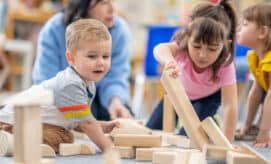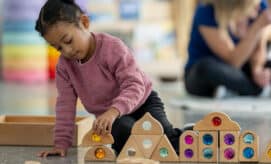Educators and caregivers who work with young children know that play is a crucial part of young children’s learning. Because children are naturally curious and inquisitive, they find joy in exploring, making new discoveries, and learning about the world around them. This play-based learning builds both academic and relation-building skills.
In this article, we take a look at the many ways children learn through play, and consider the benefits of a play-based curriculum.
How do Children Learn Through Play?
In an article for NAEYC, David Elkind, professor emeritus of Child Development at Tufts University and author of the popular book, The Power of Play, explains that play helps children gain skills and knowledge across all domains, from social-emotional to language, and cognitive, self-help, and motor. Elkind notes that “Play is the vehicle for helping children make progress toward the learning goals…It builds skills they’ll use throughout their lives, such as solving problems, interacting and negotiating with others, processing emotions, taking risks, flexibility, resilience, and self-direction.”
When we observe children in play, it might not be immediately obvious just how much learning is actually taking place. Stuart Brown, the founder of the National Institute of Play, adds that “as kids play with blocks, fashion mud pies, and throw balls, they are constantly fertilizing neural growth and integrating complex areas that the natural world offers… Children need free, hands-on play that is kid-organized, to maximize their potential. Nothing lights up a child’s brain like play.”
How Does Play Transform?
As children develop, their play becomes increasingly complex. The play of infants and toddlers will look different from the playful interactions of preschoolers — but play is equally important at each stage of development. As children grow, we can see their play transform as they take on new challenges, try new things, and learn new skills.






